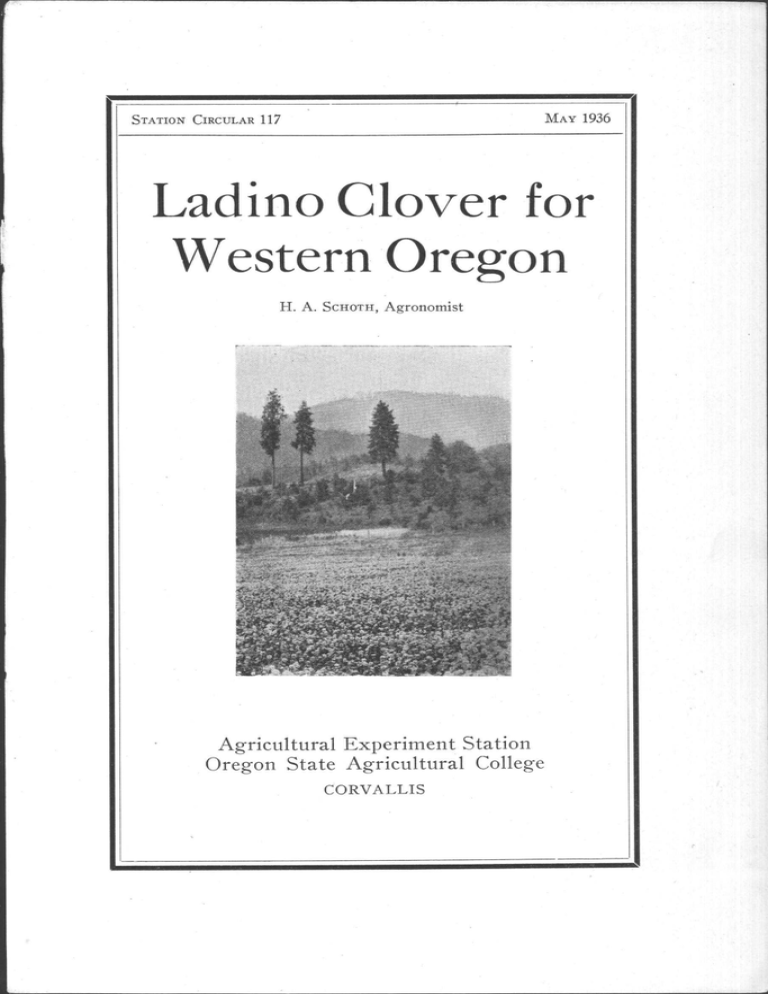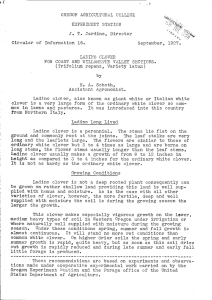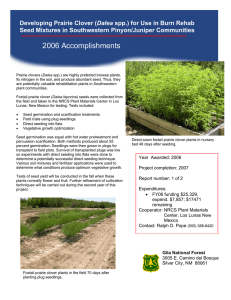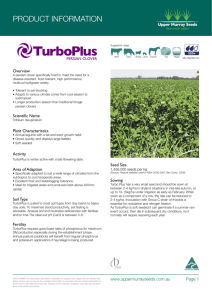Ladino Clover for Western Oregon Agricultural Experiment Station Oregon State Agricultural College
advertisement

MAY 1936 STATION CIRCULAR 117 Ladino Clover for Western Oregon H. A. SCHOTH, Agronomist Agricultural Experiment Station Oregon State Agricultural College CORVALLIS Ladino Clover for Western Oregon* By H. A. SCHOTH, Agronomistt ADINO CLOVER, trifoliunt repens, variety latuni, a native of northern Italy, also known as giant white or Italian white clover, is a very large variety of the ordinary white clover common in lawns and pastures. It is a perennial of medium long life, having short tap roots and surface stems that lie flat on the ground and commonly produce fibrous roots at the joints. The leaf stalks are long and each carries a single leaf having three large leaflets. The flowers, borne singly on long stems, are similar to those of ordinary white clover but less numerous and three to four times larger. Ladino clover, when grown under similar conditions, usually makes a growth of 8 to 12 inches in height compared to 4 to 6 inches for the ordinary white clover, and an intei-mediate height for Louisiana white clover. Ladino is not as hardy as the ordinary white clover. GROWING CONDITIONS As Ladino clover is not a deep-rooted plant, it makes its best growth where there is a constant but not excessive moisture supply in the surface and sub-surface soil. It can be grown on rather shallow land provided this land is well supplied with lime, phosphate, humus, and moisture. A larger growth is obtained on the more fertile and deep soils well supplied with moisture during the growing season. This is the case with all clovers. In Western Oregon under irrigation, or where there is abundant moisture, this clover makes especially vigorous growth on soils ranging from the lower sandy loams to the medium heavy types. Under these conditions spring, summer, and fall growth is almost continuous. Ladino is no more tolerant of wet soil conditions than common white clover, and it is especially unsuited to soils that remain saturated during the growing season. On the higher, drier soils the spring and early summer growth is rapid and quite heavy, but as soon as the soil dries out, growth is rapidly reduced. During late summer and early fall little forage is produced. Growth through the late fall, winter, and early spring periods is very slow, this condition being particularly true when temperatures of 30 to 40 degrees hold the plants in a semidormant condition. Growth stops when temperatures go below 25 degrees. Experimental observations show that if the soil is dry and frozen and unprotected by snow; continued periods of very low temperatures may result in winter injury, particularly if there is over grazing during late summer and fall. Less winter killing is experienced when the clover is grown with grass than when grown alone. "These recommendations are based on experiments and observations made under cooperative experimental work carried on by the Oregon Agricultural Experiment Station and the Division of Forage Crops and Diseases, Bureau of Plant Industry, United States Department of Agriculture. f United States Department of Agriculture, Division of Forage Crops and Diseases, Bureau of Plant Industry. 4 AGRICULTURAL EXPERIMENT STATiON CIRCULAR 117 Preparation of the seed bed. Soil preparation for Ladino clover should produce a fine, firm, weed-free seed bed. If the field is to be irrigated, it will be absolutely necessary to have it well leveled previous to seeding, so that the water can be distributed evenly and with as much uniformity of speed and economy as possible. High places that get insufficient water soon lose the Ladino when grazed. In low places where there are pools of water or where seepage accumulates, the clover drowns out. Early preparation of the land to free it of weeds and assure a well settled condition is important. An ideal seed bed is obtained by fall plowing followed in the spring by light working of the surface soil. If the seed bed appears to be too loose, which is a common occurrence, it should be rolled before seeding to prevent planting the seed too deep and to enable the seedlings to become better established. Use only good seed. Ladino clover seed is so much like common white clover that for certification, field inspection of the growing crop is necessary to determine definitely the purity of the Ladino clover. Certified seed can be purchased from seed firms and growers and its use is advisable. Specifications of the three grades for certification are as follows: BLUE TAG. Not more than 1 per cent white clover in the field on field inspection. Threshed seed shall he plump, not less than 99 per cent pure, contain not more than .6 per cent of weed seed, and not more than 300 alsike and 225 buckhorn seeds per pound. Blue Tag seed is recommended for the use of seed growers and others desiring the highest quality of seed. RED TAG. Not more than 2 per cent white clover in the field. Threshed seed shall be reasonably plump, not less than 97i per cent pure, contain not more than 1 per cent weed seed, nor 2 per cent inert matter, and not more than 675 buckhorn seeds per pound. This grade is recommended f or pasture purposes. YELLOW TAG. Not more than 10 per cent white clover in the field. Threshed seed shall be at least 90 per cent pure, and shall contain not more than 2 per cent weed seeds, nor more than 2 per cent inert matter. The certification tag shall also carry the analysis of the sample including the percentage of pure seed, other crop seeds, weed seed, and inert matter. This grade may contain not more than 675 buckhorn seeds per pound. Noxious weeds such as dodder, Johnson grass, quack grass, white top, wild morning glory, Canada thistle, or Marsh elder are not permitted in the seed of any certified grade. Seedings to be grown primarily for seed production should be made only with BLUE TAG quality seed. RED TAG and YELLOW TAG seed may contain some white clover or alsike clover seed which is inseparable from Ladino and also various amounts of weed seed and inert matter. These grades are very satisfactory for pasture or other forage purposes. Two seeding methods. Usually seeding is done by broadcasting, followed by light harrowing. A clover-seed drill that can be gauged to sow shallow and evenly in rather small amounts is an excellent implement to use. 5 LADINO CLOVER FOR WESTERN OREGON Five or six pounds of seed per acre planted alone is sufficient if the land is well prepared and comparatively free from weeds. When seeded in combination with other plants the amount of Ladino seed is reduced to three to four pounds per acre, depending on the amounts and kinds of other seeds in the mixture. Under heavy grazing it is important to have many primary or tap-rooted plants rather than to depend upon the less hardy secondary plants established from stolons. Figure 1. Livestock on Ladino clover pasture. When seeded for pasture purposes Ladino frequently is combined with grasses that fit in well as companion plants and make satisfactory growth under similar conditions. Commonly used mixtures based on experimental plantings are as follows: Pounds per acre Ladino clover Redtop English rye grass Domestic rye grass 3 4 3 3 13 Ladino clover English rye grass Meadow fescue Timothy Orchard grass 3 3 3 2 4 15 Ladino clover English rye grass Kentucky blue grass Orchard grass Meadow fescue 3 3 2 4 3 15 6 AGRICULTURAL EXPERIMENT STATION CIRCULAR 117 Avoid timothy in seed crops. Timothy should be avoided in any mixture that later may be harvested for seed. Hulled timothy is almost inseparable from the Ladino seed. Ladino clover in Western Oregon, especially in the Willamette Valley, is most successful when seeded in the spring. Seedings may be made from May 1 to July 1, depending on the season, soil, and moisture condition. Any fall seedings should be made early, September 1 to 20. They are not generally recommended. Experiments show that fall seedings when made alone are not as successful as spring seedings. Such plantings made on moist land are likely to heave out during periods of alternate freezing and thawing, but when planted with grasses, Ladino is considerably less injured. Fall-sown Ladino in Western Oregon frequently is seriously injured by slugs before rapid spring growth begins. When grown primarily for seed production seedings usually are made alone. Yields generally are larger, there is less material to handle at harvest, and cleaning operations and costs are reduced. LADINO VALUABLE FOR PASTURE, SEED, AND HAY Ladino clover either alone or in combination with other plants is grown for pasture, seed, and hay. It is primarily a pasture plant and as such produces a heavy tonnage of rich succulent feed relished by all kinds of livestock. Where a considerable acreage is grown, the fields should be divided so that rotation pasturing will provide full utilization of the crop. Any fields not used for pasture can be cut for hay or seed. When used for both pasture and hay, the spring growth is used for pasture, the early summer growth for hay, and later growth for either hay, pasture, or seed. Pasture. Ladino clover when pastured or fed green may cause bloat in cattle and sheep, although under similar conditions generally it is no worse than alfalfa. In some instances bloat has been quite serious, and it is always advisable to keep this danger in mind. Frequently it is best to keep animals known to bloat easily off of Ladino clover pasture entirely. Pure stands of Laclino clover are more likely to cause bloat than mixed seedings containing considerable proportions of grass. It has been observed that animals kept continuously on the pasture are less likely to bloat. On some soils Ladino clover responds very favorable to early March applications of landi5laster at the rate of 75 to 100 pounds per acre. Under certain conditions fertilizers applied at the rate of 150 to 300 pounds per acre are profitable. This is particularly true of fertilizers containing considerable phosphate. Unless conditions are favorable heavy nitrogen applications may stimulate a large development of grass and injure the clover. Use of phosphate fertilizers at the rate of 100 to 300 pounds an acre is particularly beneficial to pure stands of Laclino on many soils. Top dress- ing with well-rotted manure results in increased growth, and harrowing or otherwise scattering the droppings in pastured fields results in a more uniform growth that is eaten more readily by the animals. Ladino clover should be pastured as evenly as possible but not close enough to injure the creeping stems on the surface of the soil. Rotation grazing is a very desirable practice for this clover, resulting in more even LADINO CLOVER FOR WESTERN OREGON 7 grazing, less waste, and increased production. When given an opportunity to grow unmolested for short periods the clover makes a more rapid growth than when subjected to continual grazing. Research indicates that Ladino clover should reach a height of approximately four inches before pasturing begins in the spring. Stock should be removed before the end of the growing season in the late fall. Close pasturing in the fall is no.t advisable because stands of Ladino clover when grazed too closely particularly those seeded alone, are injured by severe winter weather conditions. Mixed stands of Ladino and grasses, however, can be grazed more closely without quite as much danger of injury. Animals injure the fleshy stolons severely if they are allowed on the field when plants and soil are frozen. Figure 2. A good stand of Ladino clover. Seed production. In the production of Ladino clover seed the spring growth frequently is used for pasture, the stock being taken off the fields about May 15 and the growth from then on allowed to mature. Under some irrigated conditions two sets, or crops, of blossoms are developed to the mature stage before harvesting. Where irrigation water is properly and evenly distributed and the first set of practically mature blossoms is not destroyed or kept wet too long, this practice often results in increased seed yields. A rather long growing season is desirable for this practice. Some growers use the entire season's growth for seed, producing a succession of flowers that are cut at one cutting in the fall. The crop is ready to cut when 90 per cent of the visible heads are brown and mature enough to thresh when dry. The seed may be harvested with a mower with bunching attachment or swather. As vigorous growing, green Ladino is very difficult to cut, irrigation water is kept off the land for ten days to two weeks before harvest. As soon as the crop is well dried it should be hulled, the ordinary clover seed huller being very satisfactory. Yields will vary from 100 to 400 pounds of seed per acre, depending on the fer- 8 AGRICULTURAL EXPERIMENT STATION CIRCULAR 117 tility of the soil, the stand, and the growing conditions under which the crop is produced. If a full stand is maintained more seed is produced as the plants advance in age. Production of certified seed must include inspection of fields previous to cutting. After removing the crop fronfi the field, irrigation is desirable to stimulate fall growth. Hay. Ladino clover hay is of excellent quality, being very rich in protein, and is consumed readily by all kinds of livestock, although it is of specific value for dairy cattle and sheep. Analyses of the hay made by J. S. Jones and J. R. Haag of the Oregon Agricultural Experiment Station, calculated on the dry basis, show a range in protein of 11.8 to 24.2 per cent. The high protein content is found in the more immature clover and the lower percentages are found in hay cut after the blooms begin to mature. This clover is more frequently used as a hay plant on soils too wet or shallow for alfalfa. When used for hay Ladino should be cut when in full bloom because at that time the maximum amount of high-quality forage is available. Because of its fine character and leafiness, curing should be reasonably rapid and the hay handled as few times as possible so as to avoid the loss of leaves. After it is thoroughly wilted the final curing generally is in the shock. Care must be taken not to shock the clover when too green or in too large shocks because molding may take place during the rapid settling of the hay. Three cuttings a year can be made under ordinary moist land conditions. The tonnage per acre for each cutting is not large because the hay consists mostly of leaves and leaf stems. STANDS MEDIUM LONG LIVED Good stands of Ladino clover on suitable land and properly handled should produce well for four to eight years although it is almost impossible to keep the stands from getting grassy as they get older. As soon as the percentage of grass gets larger than that of clover it may be advisable to break up the sod and plant to other crops unless the quality and quantity of the remaining combination is such that it can be profitably utilized for forage. The use of Ladino clover instead of white clover in pasture mixtures on land reasonably well supplied with summer moisture usually results in increased amounts of pasture. This is especially true in the coast districts or where irrigation is practiced. Cultivation to destroy weeds and grass is not successful because of the heavy loss of stems and plants due to the shallow rooting system. Stands of Ladino clover on sour soils frequently are stimulated by applications of one to two tons of lime per acre. Many good stands have been secured, however, without the use of lime because Ladino appears better suited to slightly acid soil conditions than some other clovers. To obtain a maximum yield of Ladino clover grown under irrigation, frequent applications of water are advisable because of the shallow rooting habit. Common white clover probably will be more productive on poor dry soils because little forage can be expected from the Ladino plant under such conditions.




